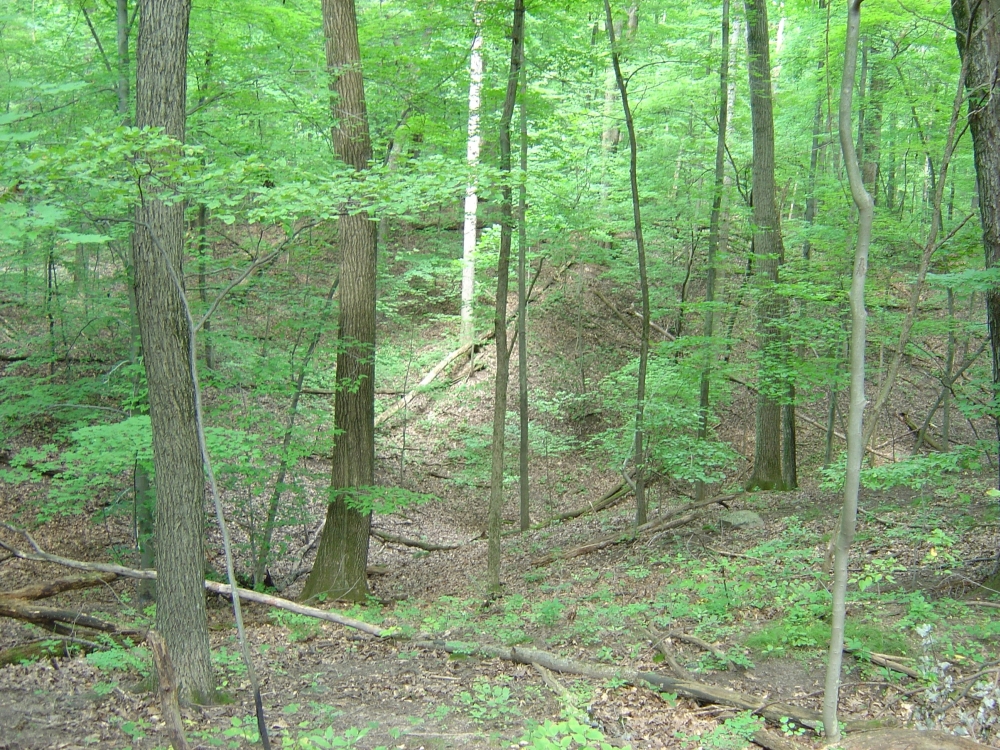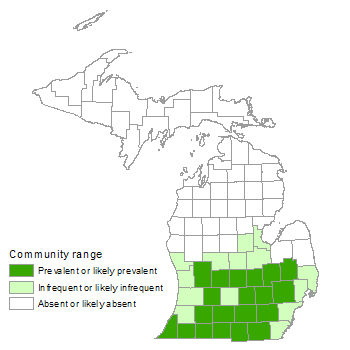Dry-mesic Southern Forest
Overview
Dry-mesic southern forest is a fire-dependent, oak or oak-hickory forest type on generally dry-mesic sites found south of the climatic tension zone in southern Lower Michigan. Frequent fires maintain semi-open conditions, promoting oak regeneration and ground and shrub layer diversity.
Rank
Global Rank: G4 - Apparently secure
State Rank: S3 - Vulnerable

Landscape Context
This natural community occurs principally on glacial outwash, coarse-textured moraines, sandy glacial lakeplains, kettle-kame topography, and sand dunes.
Soils
Soils are typically sandy loam or loam and slightly acid to neutral in pH.
Natural Processes
Fire, windthrow, and insect outbreaks and pathogens associated with oak defoliation and decline are the prevalent natural disturbance factors influencing dry-mesic southern forest. Historically, frequent, low-intensity surface fires generated conditions suitable for sustaining advanced oak regeneration and helped keep oak pathogens and invertebrate acorn predators at low levels. Tree density in circa 1800 oak forests was likely lower than that observed today under conditions of fire suppression, and helped limit root-grafting and the spread of several oak pathogens. Frequent small-scale wind disturbance or gap-phase dynamics allows for growth of suppressed oak saplings and canopy ascension of understory oaks. Prolonged periods of fire suppression in oak openings can result in the succession to closed-canopy dry-mesic southern forest and likely accounts for the existence of many oak forests observed today.
Vegetation
The canopy layer generally is dominated or codominated by white oak (Quercus alba) and black oak (Quercus velutina), with white oak being the more frequent dominant. Red oak (Q. rubra) can occur as a canopy codominant, especially where soils and topographic position favor less droughty conditions such as north- to east-facing slopes and footslopes. Hickories such as pignut hickory (Carya glabra), shagbark hickory (C. ovata), and bitternut hickory (C. cordiformis) are often canopy codominants. Prevalent canopy associates may include red maple (Acer rubrum), white ash (Fraxinus americana), black cherry (Prunus serotina), Hill's oak (Quercus ellipsoidalis), basswood (Tilia americana), and sassafras (Sassafras albidum). Prevalent species of the subcanopy include red maple, hickories, alternate-leaved dogwood (Cornus alternifolia), flowering dogwood (C. florida), ironwood (Ostrya virginiana), cherries (Prunus spp.), and sassafras. Characteristic shrubs include serviceberries (Amelanchier spp.), witch hazel (Hamamelis virginiana), and choke cherry (Prunus virginiana). In fire-suppressed systems, mesophytic trees and shrubs are often dominant in the subcanopy and shrub layers. Typical herbaceous species include doll’s eyes (Actaea pachypoda), hog peanut (Amphicarpaea bracteata), jack-in-the-pulpit (Arisaema triphyllum), bearded shorthusk (Brachyelytrum erectum), hairy woodland brome (Bromus pubescens), white bear sedge (Carex albursina), rosy sedge (C. rosea), enchanter's nightshade (Circaea canadensis), spotted coral-root (Corallorhiza maculata), pointed-leaf tick-trefoil (Hylodesmum glutinosum), naked-flower tick-trefoil (H. nudiflorum), fragrant bedstraw (Galium triflorum), black snakeroot (Sanicula marilandica), bristly greenbrier (Smilax hispida), large-flowered bellwort (Uvularia grandiflora), and downy yellow violet (Viola pubescens).
For information about plant species, visit the Michigan Flora website.
Plant Lists
Graminoids
- autumn bent (Agrostis perennans)
- long-awned wood grass (Brachyelytrum erectum)
- Canada brome (Bromus pubescens)
- sedges (Carex albursina, C. cephalophora, C. communis, C. digitalis, C. pensylvanica, C. rosea, and others)
- poverty grass (Danthonia spicata)
- panic grasses (Dichanthelium spp.)
- bottlebrush grass (Elymus hystrix)
- nodding fescue (Festuca subverticillata)
- cut-leaved rice-grass (Oryzopsis asperifolia)
Forbs
- doll’s eyes (Actaea pachypoda)
- tall agrimony (Agrimonia gryposepala)
- hog-peanut (Amphicarpaea bracteata)
- wild columbine (Aquilegia canadensis)
- wild sarsaparilla (Aralia nudicaulis)
- poke milkweed (Asclepias exaltata)
- false foxglove (Aureolaria spp.)
- enchanter’s-nightshade (Circaea canadensis)
- wild yam (Dioscorea villosa)
- large-leaved aster (Eurybia macrophylla)
- bedstraws (Galium circaezans, G. triflorum, and others)
- wild geranium (Geranium maculatum)
- round-leaved hepatica (Hepatica americana)
- pointed-leaf tick-trefoil (Hylodesmum glutinosum)
- naked-flower tick-trefoil (Hylodesmum nudiflorum)
- Canada mayflower (Maianthemum canadense)
- false spikenard (Maianthemum racemosum)
- hairy sweet cicely (Osmorhiza claytonii)
- jumpseed (Persicaria virginiana)
- lopseed (Phryma leptostachya)
- may apple (Podophyllum peltatum)
- large-leaved shinleaf (Pyrola elliptica)
- black snakeroots (Sanicula spp.)
- bluestem goldenrod (Solidago caesia)
- elm-leaved goldenrod (Solidago ulmifolia)
- early meadow-rue (Thalictrum dioicum)
- rue-anemone (Thalictrum thalictroides)
- common trillium (Trillium grandiflorum)
- large-flowered bellwort (Uvularia grandiflora)
- merrybells (Uvularia sessilifolia)
- downy yellow violet (Viola pubescens)
Ferns
- rattlesnake fern (Botrypus virginianus)
- bracken fern (Pteridium aquilinum)
Woody Vines
- Virginia creeper (Parthenocissus quinquefolia)
- bristly greenbrier (Smilax hispida)
- poison-ivy (Toxicodendron radicans)
- summer grape (Vitis aestivalis)
- riverbank grape (Vitis riparia)
Shrubs
- serviceberries (Amelanchier spp.)
- gray dogwood (Cornus foemina)
- American hazelnut (Corylus americana)
- wintergreen (Gaultheria procumbens)
- huckleberry (Gaylussacia baccata)
- witch-hazel (Hamamelis virginiana)
- choke cherry (Prunus virginiana)
- prickly gooseberry (Ribes cynosbati)
- common blackberry (Rubus allegheniensis)
- black raspberry (Rubus occidentalis)
- wild red raspberry (Rubus strigosus)
- low sweet blueberry (Vaccinium angustifolium)
- Canada blueberry (Vaccinium myrtilloides)
- hillside blueberry (Vaccinium pallidum)
- maple-leaved arrow-wood (Viburnum acerifolium)
Trees
- red maple (Acer rubrum)
- juneberry (Amelanchier arborea)
- bitternut hickory (Carya cordiformis)
- pignut hickory (Carya glabra)
- shagbark hickory (Carya ovata)
- alternate-leaved dogwood (Cornus alternifolia)
- flowering dogwood (Cornus florida)
- white ash (Fraxinus americana)
- ironwood (Ostrya virginiana)
- black cherry (Prunus serotina)
- white oak (Quercus alba)
- northern pin oak (Quercus ellipsoidalis)
- red oak (Quercus rubra)
- black oak (Quercus velutina)
- sassafras (Sassafras albidum)
- basswood (Tilia americana)
Noteworthy Animals
The now extinct passenger pigeon (Ectopistes migratorius) was likely a keystone species in oak ecosystems, roosting in oak forests by the thousands.
Rare Plants
- Agrimonia rostellata (beaked agrimony, state special concern)
- Arabis missouriensis var. deamii (Missouri rock-cress, state special concern)
- Aristolochia serpentaria (Virginia snakeroot, state threatened)
- Baptisia leucophaea (cream wild indigo, state endangered)
- Castanea dentata (American chestnut, state endangered)
- Dennstaedtia punctilobula (hay-scented fern, state threatened)
- Eupatorium sessilifolium (upland boneset, state threatened)
- Geum virginianum (pale avens, state special concern)
- Houstonia caerulea (bluets, state special concern)
- Linum virginianum (Virginia flax, state threatened)
- Liparis liliifolia (purple twayblade, state special concern)
- Quercus shumardii (Shumard's oak, state special concern)
- Scutellaria elliptica (hairy skullcap, state special concern)
- Silene stellata (starry campion, state threatened)
- Silene virginica (fire pink, state threatened)
- Triphora trianthophora (three-birds orchid, state threatened)
- Viburnum prunifolium (black haw, state special concern)
Rare Animals
- Accipiter cooperii (Cooper’s hawk, state special concern)
- Ambystoma opacum (marbled salamander, state threatened)
- Anguispira kochi (banded globe, state special concern)
- Battus philenor (pipevine swallowtail, state special concern)
- Buteo lineatus (red-shouldered hawk, state threatened)
- Catocala dulciola (quiet underwing, state special concern)
- Catocala robinsoni (Robinson’s underwing, state special concern)
- Dendroica cerulea (cerulean warbler, state special concern)
- Elaphe o. obsoleta (black rat snake, state special concern)
- Emydoidea blandingii (Blanding’s turtle, state special concern)
- Erynnis baptisiae (wild indigo duskywing, state special concern)
- Fixsenia favonius ontario (northern hairstreak, state special concern)
- Mesomphix cupreus (copper button, state special concern)
- Microtus pinetorum (woodland vole, state special concern)
- Neoconocephalus retusus (conehead grasshopper, state special concern)
- Nerodia erythrogaster neglecta (copperbelly watersnake, federal threatened and state endangered)
- Nicrophorus americanus (American burying beetle, federal/state endangered)
- Oecanthus pini (pinetree cricket, federal/state endangered)
- Papaipema cerina (golden borer, state special concern)
- Pygarctia spraguei (Sprague’s pygarctia, state special concern)
- Sistrurus c. catenatus (eastern massasauga, federal candidate species and state special concern)
- Terrapene c. carolina (eastern box turtle, state special concern)
- Vallonia albula (land snail, state special concern)
- Wilsonia citrina (hooded warbler, state special concern)
- Xolotrema denotata (velvet wedge, state special concern)
Biodiversity Management Considerations
Fire is the single most significant factor in preserving oak ecosystems. The use of prescribed fire is an imperative management tool for promoting oak regeneration, deterring the succession of shade-tolerant species, and reducing the encroachment by invasive shrubs such as honeysuckles and autumn olive. Fire management should be orchestrated in conjunction with the management of fire-dependent communities such as oak barrens, dry sand prairie, prairie fen, and coastal plain marsh. Many current dry-mesic southern forests are degraded oak openings that have been long deprived of fire. Open canopy conditions can be restored by mechanical thinning or girdling. Restored sites will need to be maintained by periodic prescribed fire and may require investment in native plant seeding where seed and plant banks are inadequate. Herbicide application to stumps is likely necessary where woody invasive species or red maple are well established.
Monitoring and control efforts to detect and remove invasive species are critical to the long-term viability of dry southern forest. Invasive species that threaten the diversity and community structure include garlic mustard (Alliaria petiolata), black swallow-wort (Vincetoxicum nigrum), white swallow-wort (V. rossicum), Oriental bittersweet (Celastrus orbiculatus), common buckthorn (Rhamnus cathartica), autumn olive (Elaeagnus umbellata), Eurasian honeysuckles (Lonicera morrowii, L. japonica, L. maackii, L. tatarica, L. xbella, and L. xylosteum), multiflora rose (Rosa multiflora), and Norway maple (Acer platanoides).
Variation
Red oak can occur as a codominant on moister soils. Toward the transition zone, white pine (Pinus strobus) becomes a canopy associate.
Similar Natural Communities
Dry southern forest, dry-mesic northern forest, mesic southern forest, and oak openings.
Places to Visit
- Aman Park, City of Grand Rapids, Ottawa Co.
- Forked Lake Woods and Mann Street Woods, Crane Pond State Game Area, Cass Co. Haven Hill, Highland State Recreation Area, Oakland Co.
- Norris Road Woods (Devil's Soupbowl) and Hall Lake, Yankee Springs State Recreation Area, Barry, Co.
- Pickerel Lake Complex, Pinckney State Recreation Area, Washtenaw Co.
- Seven Lakes, Seven Lakes State Park, Oakland Co.
- The Hills and Gun Lake Woods, Barry State Game Area, Barry Co.
Relevant Literature
- Abrams, M.D. 1992. Fire and the development of oak forests. BioScience 42(5): 346-353.
- Brewer, L.G., T.W. Hodler, and H.A. Raup. 1984. Presettlement vegetation of southwestern Michigan. Michigan Botanist 23: 153-156.
- Curtis, J.T. 1959. The vegetation of Wisconsin. University of Wisconsin Press, Madison, WI. 657 pp.
- Lee, J.G. 2007. Natural community abstract for dry-mesic southern forest. Michigan Natural Features Inventory, Lansing, MI. 15 pp.
- Minc, L.D., and D.A. Albert. 1990. Oak-dominated communities of southern Lower Michigan: Floristic and abiotic comparisons. Michigan Natural Features Inventory, Lansing, MI. Unpublished manuscript. 103 pp.
- Rodewald, A.D. 2003. Decline of oak forests and implications for forest wildlife conservation. Natural Areas Journal 23(4): 368-371.
For a full list of references used to create this description, please refer to the natural community abstract for Dry-mesic Southern Forest.
More Information
Citation
Cohen, J.G., M.A. Kost, B.S. Slaughter, D.A. Albert, J.M. Lincoln, A.P. Kortenhoven, C.M. Wilton, H.D. Enander, and K.M. Korroch. 2020. Michigan Natural Community Classification [web application]. Michigan Natural Features Inventory, Michigan State University Extension, Lansing, Michigan. Available https://mnfi.anr.msu.edu/communities/classification. (Accessed: December 21, 2025).
Kost, M.A., D.A. Albert, J.G. Cohen, B.S. Slaughter, R.K. Schillo, C.R. Weber, and K.A. Chapman. 2007. Natural Communities of Michigan: Classification and Description. Michigan Natural Features Inventory, Report No. 2007-21, Lansing, MI.


